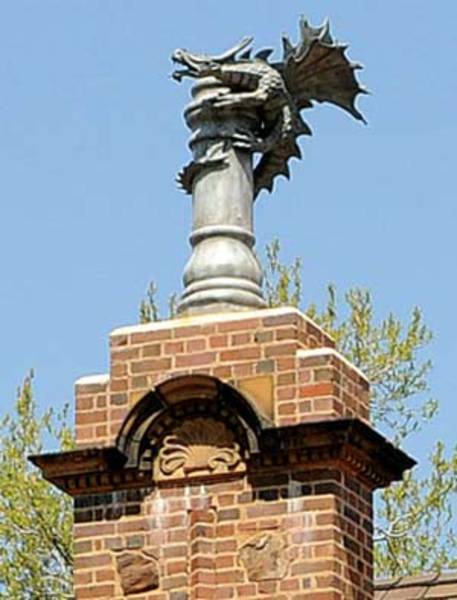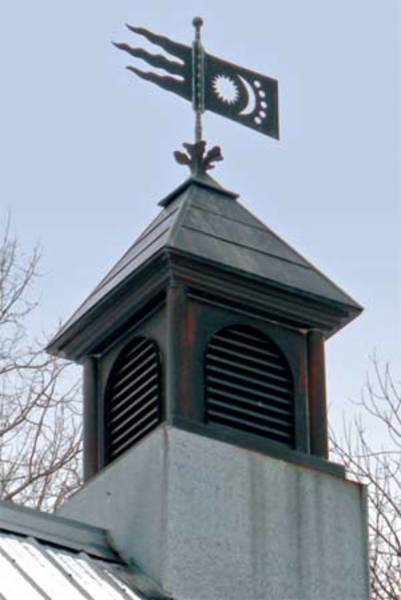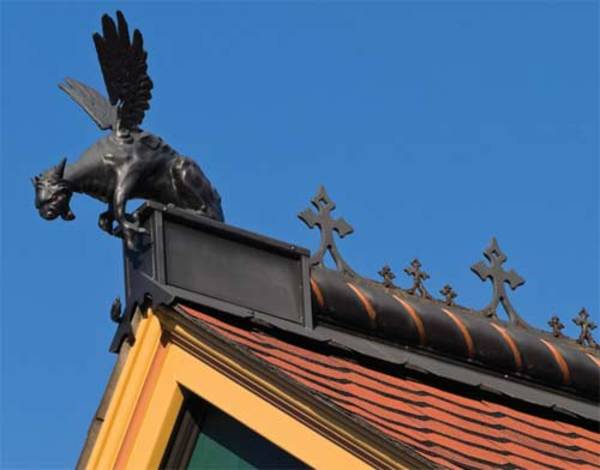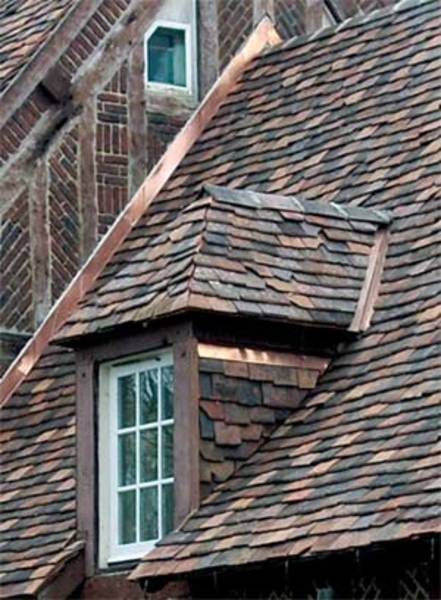
The stupendous Guardian Dragon custom pot in painted clay is by ChimneyPot.com.
A knockout roof is truly a fitting cap to your restoration (particularly of a Victorian house). Whatever the roofing material, you can add a little or a lot of interest.
Chimney Pots
Take chimney pots, for example, which have been common in Britain and Europe and are catching on here. Practical as well as decorative, they make the chimney taller, which creates a stronger draft and pulls more smoke out of the flue; they also keep out pests, and rain that may lead to mold and mildew.
The Chimney Pot Shoppe carries hundreds of choices, from vintage English imports to newly cast models. Measure diagonally across the flue pipe to determine how wide the inside of the pot should be, as it must cover the flue, and measure the chimney itself to ensure the pot will sit firmly on it and not extend over the edges.
Installation involves removing excess flue tile from the top of the chimney (ensuring that water doesn’t become trapped between flue and pot, where freezing would cause damage). Then a 3″ bed of mortar is laid around the chimney, completely covering the flue. The chimney pot goes in the mortar, which is then troweled up the pot to provide a sluice for rainwater. The mortar should be checked about once a decade but otherwise is maintenance-free.
Jack Arnold at European Copper has taken chimney pots into the 21st century, making them from lighter-weight but beautiful copper in octagonal, square, and round models, suitable for houses from gabled Queen Annes to Craftsman bungalows. Designed to fit masonry as well as pre-fabricated flues, the copper pots come with a straightforward system of mounting brackets and gaskets. With chimney pots, consider proportion: a 5′ chimney pot that seems tall next to you on the ground can easily disappear on the roof. A rule of thumb is that a pot should be 9 to 15 percent of the height to which the chimney rises.

Vulcan Supply’s three-foot-long “Moon & Stars Banner” weathervane on a barn.
Weathervanes
Weathervanes have been a tradition in this country since the colonial period. George Washington had one commissioned in the form of a peace dove for Mount Vernon, to celebrate the end of the Revolutionary War.
Whether you have a colonial farmhouse or a mansard-roofed mansion, Vulcan Supply makes a design to fit. Durable and maintenance-free, their weathervanes are made from a solid brass shaft with a stainless-steel ball bearing for smooth movement, all lock-bolted to an interior collar tie.
The shaft is completely enclosed by copper tubing that seals it against water infiltration. Finials are handmade with Revere copper, precisely fitted, and soldered for watertight seams.
Cresting
Ornamental roof cresting came into its own during the mid-19th century as a decorative complement to finials and weathervanes. Traditionally made of cast iron, today’s cresting is usually made from plate steel, which is less expensive and lighter weight, making installation much easier.

A custom-cast griffin finishes iron roof cresting made from a salvaged cemetery fence.
You don’t need a pitched roof to display a run of decorative spears and spikes; Capital Cresting provides cresting with brackets that work on not only standard-pitch roof ridges (with and without venting), but also with flat roofs, where the cresting is mounted along the perimeter.
Clay roofs have been a tradition for centuries in the Orient and in Europe. They often had finials and figures of ceramic. You don’t have to own a manor to use some ornament; Team Fritz Clay Roof Tiles carries a wide selection, from pinecones that promise good health and protection, to owls and dragons. Figures are screwed into the roof crest, and “liquid nails” adhesive is used to secure the perimeter. For a big selection of both salvaged and new tile-roof finials and fittings, try Tile Roofs, Inc.

A blend of tiles from Tile Roofs Inc. covers an old house in Lake Forest, Illinois.
The roof cladding, of course, can itself be the ornamentation, especially when it comes to variegated or graduated slate shingles, steam-bent or fancy-cut wood shingles, and the myriad forms of clay and concrete tile. Shingles cut with curved, fish-scale, sawtooth, and diamond butts are the specialty of Custom Cedar Solutions. For colorful shingled roofs, Dow’s Eastern White Cedar Shingles and shakes from Maine take stain evenly.







